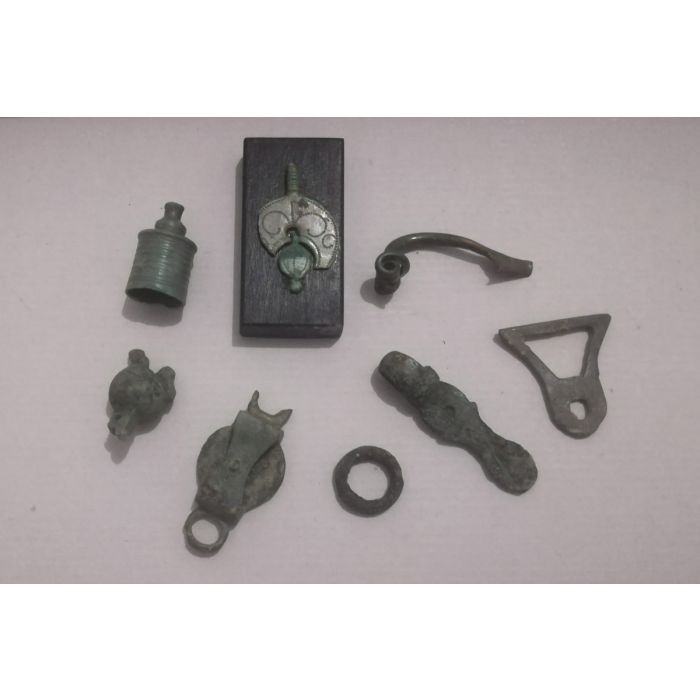Eight Roman bronze artefacts
Price: on request
Sold
Object number
AR3400C011
| Object: |
8 Roman bronze artefacts
|
| Material: |
Bronze.
|
| Period: |
1st to 4th century AD. Roman period. |
| Description: |
Eight artefacts made of bronze. One fibula, one pendant or attachment, one bronze ring and five unattributed bronze fragments or objects, repsectively. All are finds from the Roman city of Novaesium, today's Neuss in Germany.
|
| Dimensions: |
Approx. 2cm to 5cm diameter or length, respectively.
|
| Condition: |
Fragments. One piece with a sticker from the Voigtmann collection stating Neuss as the find spot ("1973 Neuß /PH a.d. Kölner Str. B. V. / 2 Teile Voi").
|
| Provenance: |
Acquired by us in 2021 from the German family estate Voigtmann. The founder of the collection, Mr. Heinz Voigtmann, carried out excavations himself between 1966 and 1981, in cooperation with local archaeologists. The artefacts offered here come from his finds near Neuss, Germany, the former Roman city of Novaesium. The Voigtmann Collection is a private collection built with passion and expertise. It included objects from the Roman Imperial period, as well as isolated objects from the Middle Ages, above all everyday pottery, but also glasses, bronzes and works of ivory. All come from the Roman city of Novaesium and its immediate vicinity. Mr. Voigtmann himself conducted excavations and recovered the objects for which the local archaeologists had no research capacities and which without him would have been lost forever. He shared his finds with the world of academia. He was in constant contact with the archaeologists Dr. Gustav Mueller, Dr. Ernst Kuenzl and Dr. Dorothea Haupt from the Rheinisches Landesmuseum Bonn, as well as with Prof. Dr. Hilmar von Platen from the University of Mainz. The Rheinisches Landesmuseum Bonn, for example, mentions the Voigtmann Collection among its new accessions from 1971. With his academic contacts and his skill as a restorer, Mr. Voigtmann devoted himself to the detailed restoration and reconstruction of the artefacts and even the sherds in his collection. This service for the preservation of the cultural heritage of the city of Neuss is unique and would not have been feasible with this effort, neither in research nor in the art market. We have the utmost respect for this life's work and have intensively curated and digitized the collection in order to preserve the provenance information and academic notes handed down for posterity in the long term. Novaesium was an early Roman foundation in the province of Germania inferior, making it one of the oldest cities in Germany. The place of its founding was certainly inhabited before the Romans and was strategically well located for holding Gaul. It was at the end of a Roman long distance road and close to the Rhine, Erft, Lippe, Ruhr and Wupper waterways. Traders settled and permanently stationed soldiers secured the junction and the nearby Limes. No wonder that today's Neuss is rich in archaeological finds, legacies from the Roman legions, as well as commercial goods and household goods from the Roman civilian population. The Voigtmann Collection forms a perfect cross-section of Roman Novaesian through the exclusively local finds and the specialization on the first centuries AD. |
| Literature: |
From the extensive literature on Roman Neuss, we would like to refer to one more general book and one exemplary description of an excavation. Both were written by local archaeologists who were friends of Mr. Voigtmann. H. Chantraine, Dr. G. Mueller, Das roemische Neuss (Stuttgart 1984). D. Haupt, Die Kleinfunde eines roemischen Landhauses aus Neuss-Weckhoven, in Beitraege zur Archaeologie des roemischen Rheinlandes, Rheinische Ausgrabungen 3 (1968). |
| Authenticity: |
We unconditionally guarantee the authenticity of every artefact, all items are subject to our lifetime return policy on authenticity.
|


